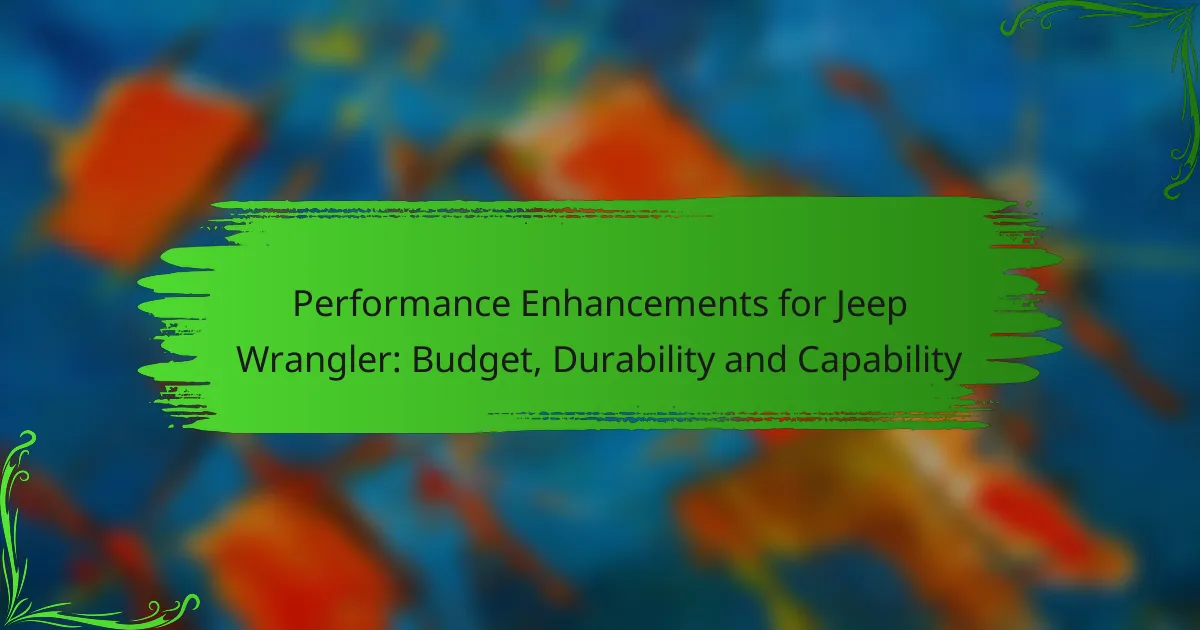Enhancing the performance of a Jeep Wrangler involves a strategic approach to improve power, efficiency, and off-road capability. Key upgrades such as cold air intakes, performance exhaust systems, and suspension enhancements not only elevate performance but also bolster durability, ensuring the vehicle can handle tough terrains. Budget considerations play a crucial role, as the range of modifications can vary significantly in cost, allowing for both economical and premium options to suit different needs.

What Are the Best Performance Enhancements for Jeep Wrangler?
The best performance enhancements for a Jeep Wrangler focus on improving power, efficiency, and off-road capability. Key upgrades include cold air intakes, performance exhaust systems, ECU tuning, suspension upgrades, and gear ratio changes.
Cold Air Intakes
Cold air intakes enhance engine performance by allowing cooler, denser air to enter the engine, which can improve combustion efficiency. This upgrade typically results in a noticeable increase in horsepower and torque, especially in models with larger engines.
When selecting a cold air intake, consider compatibility with your specific Wrangler model and engine type. Popular brands often offer kits that are easy to install and come with necessary hardware.
Performance Exhaust Systems
Performance exhaust systems improve exhaust flow, which can lead to better engine performance and a more aggressive sound. These systems often replace restrictive factory components, allowing for increased horsepower and torque output.
Look for systems made from high-quality materials like stainless steel for durability. Installation can vary from straightforward bolt-on systems to more complex setups requiring professional help.
ECU Tuning
ECU tuning involves reprogramming the engine’s computer to optimize performance parameters such as fuel mixture and ignition timing. This can lead to significant improvements in horsepower and torque, as well as better fuel efficiency.
Consider using a reputable tuner or tuning software that is compatible with your Wrangler. Be aware that some tuning options may void warranties or not comply with local emissions regulations.
Suspension Upgrades
Suspension upgrades enhance off-road capability and ride quality by improving shock absorption and handling. Options include upgrading shocks, springs, and sway bars, which can provide a smoother ride over rough terrain.
Choose suspension kits based on your intended use, whether for daily driving or extreme off-roading. A lift kit may also be beneficial for increased ground clearance and better approach angles.
Gear Ratio Changes
Changing the gear ratios in your Jeep’s differential can improve acceleration and towing capacity, especially after installing larger tires. Lower gear ratios provide more torque at the wheels, which is advantageous for off-road driving.
When considering gear ratio changes, factor in the size of your tires and the type of driving you do. A common range for off-road enthusiasts is between 4.10 and 4.88, depending on the tire size and engine configuration.

How Do Performance Enhancements Improve Durability?
Performance enhancements can significantly boost the durability of a Jeep Wrangler by reinforcing its components and optimizing its systems. These upgrades help the vehicle withstand harsh conditions and extend its lifespan, making it more reliable for off-road adventures.
High-Quality Materials
Using high-quality materials in performance enhancements can greatly improve the durability of a Jeep Wrangler. Upgrading parts like the exhaust system, suspension, and drivetrain with stronger alloys or composites can reduce wear and tear over time. For instance, stainless steel exhaust systems resist corrosion better than standard options, ensuring longevity.
When selecting materials, consider options that offer a balance between weight and strength. Lightweight yet durable materials can enhance performance without compromising structural integrity. Always check for warranties or certifications that indicate quality standards.
Improved Engine Cooling
Enhanced engine cooling systems are crucial for maintaining durability, especially during heavy use or extreme conditions. Upgrading to a high-performance radiator or adding an auxiliary cooler can prevent overheating, which is a common issue that leads to engine failure. Keeping engine temperatures within optimal ranges can extend its life significantly.
Consider installing a thermostat that opens at a lower temperature to ensure better cooling during demanding situations. Regular maintenance, such as flushing the coolant system, is also essential to keep the cooling system functioning effectively.
Enhanced Suspension Components
Upgrading suspension components can improve the durability of a Jeep Wrangler by providing better support and stability on rough terrains. High-performance shocks and springs can absorb impacts more effectively, reducing stress on the vehicle’s frame and body. This not only enhances ride quality but also minimizes the risk of damage during off-road excursions.
When selecting suspension upgrades, look for options that are designed for your specific driving conditions. Heavy-duty components may be necessary for frequent off-roading, while lighter options might suffice for occasional use. Regularly inspect suspension parts for wear and replace them as needed to maintain optimal performance.

What Are the Cost Considerations for Upgrades?
When considering performance enhancements for a Jeep Wrangler, budget is a critical factor. Costs can vary widely based on the type of upgrades, ranging from affordable modifications to high-end performance parts that significantly boost capability.
Budget-Friendly Options
Budget-friendly upgrades typically range from $100 to $500 and can significantly improve your Jeep’s performance without breaking the bank. Common options include upgrading air filters, adding a performance exhaust system, or installing a simple tuner.
These modifications enhance engine efficiency and responsiveness, providing noticeable improvements in power and fuel economy. Always ensure that any parts you choose are compatible with your specific Wrangler model to avoid unnecessary expenses.
Mid-Range Enhancements
Mid-range enhancements usually cost between $500 and $2,000 and offer a balance between performance and investment. Popular choices include suspension lifts, upgraded tires, and performance chips that optimize engine output.
These enhancements not only improve off-road capability but also enhance on-road handling. When selecting mid-range parts, consider the long-term benefits versus initial costs to ensure you are making a wise investment.
High-End Performance Parts
High-end performance parts can range from $2,000 to $10,000 or more, depending on the complexity and brand. These upgrades often include advanced suspension systems, superchargers, and high-performance braking systems.
While these parts provide the most significant performance gains, they require careful consideration of your Jeep’s intended use and your budget. Investing in high-end components can lead to exceptional durability and capability, but ensure that they align with your overall goals for your Wrangler.

How Do Performance Enhancements Affect Off-Road Capability?
Performance enhancements significantly improve off-road capability by optimizing traction, ground clearance, and approach and departure angles. These modifications allow the Jeep Wrangler to navigate challenging terrains more effectively, enhancing both safety and driving experience.
Increased Traction
Increased traction is crucial for off-road driving, as it allows the Jeep Wrangler to maintain grip on slippery or uneven surfaces. Upgrading tires to all-terrain or mud-terrain options can enhance grip, especially in wet or loose conditions. Consider using tires with deeper treads for better performance in mud and snow.
Additionally, installing a limited-slip differential or locking differentials can further improve traction by distributing power more evenly to the wheels. This is particularly beneficial when one wheel is off the ground or on a slick surface.
Better Ground Clearance
Better ground clearance is essential for navigating obstacles like rocks, logs, and deep ruts. Increasing the lift height of the Jeep Wrangler through suspension upgrades can provide additional clearance, typically ranging from 2 to 4 inches. This modification helps prevent undercarriage damage and allows for smoother passage over rough terrain.
When considering lift kits, it’s important to balance height with stability. A higher lift can improve capability but may affect handling on paved roads. Always choose a reputable brand that meets safety standards to ensure durability.
Improved Approach and Departure Angles
Improved approach and departure angles are vital for tackling steep inclines and declines without damaging the vehicle. Enhancements such as bumpers designed for off-road use can increase these angles, allowing the Jeep Wrangler to approach obstacles more aggressively. Typically, a good approach angle is around 30 degrees or more.
When modifying your Wrangler, consider the trade-off between aesthetics and functionality. While some aftermarket parts may look appealing, they should not compromise the vehicle’s ability to navigate challenging terrains. Always verify that modifications comply with local regulations to avoid legal issues.

What Are the Compatibility Factors for Upgrades?
Compatibility factors for upgrades on a Jeep Wrangler include model year variations and engine type considerations. Understanding these factors ensures that enhancements align with your vehicle’s specifications and performance goals.
Model Year Variations
Different model years of the Jeep Wrangler may have distinct compatibility requirements for upgrades. For instance, modifications available for a 2020 model may not fit a 2015 model due to changes in design and technology.
When considering upgrades, check the specific parts and accessories designed for your model year. This can include suspension kits, exhaust systems, and performance chips that are tailored to the engine and chassis configurations of that particular year.
Engine Type Considerations
The engine type in your Jeep Wrangler significantly impacts the compatibility of performance enhancements. For example, a Wrangler with a V6 engine may have different upgrade options compared to a turbocharged four-cylinder variant.
When selecting upgrades, ensure they are compatible with your engine type. Research options like cold air intakes or performance tuners that are specifically designed for your engine configuration to maximize efficiency and power without risking damage.
